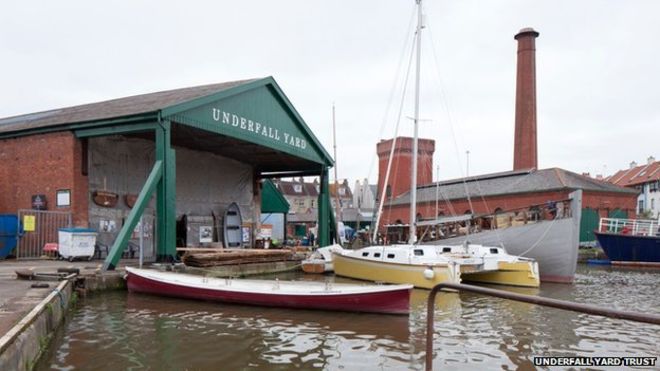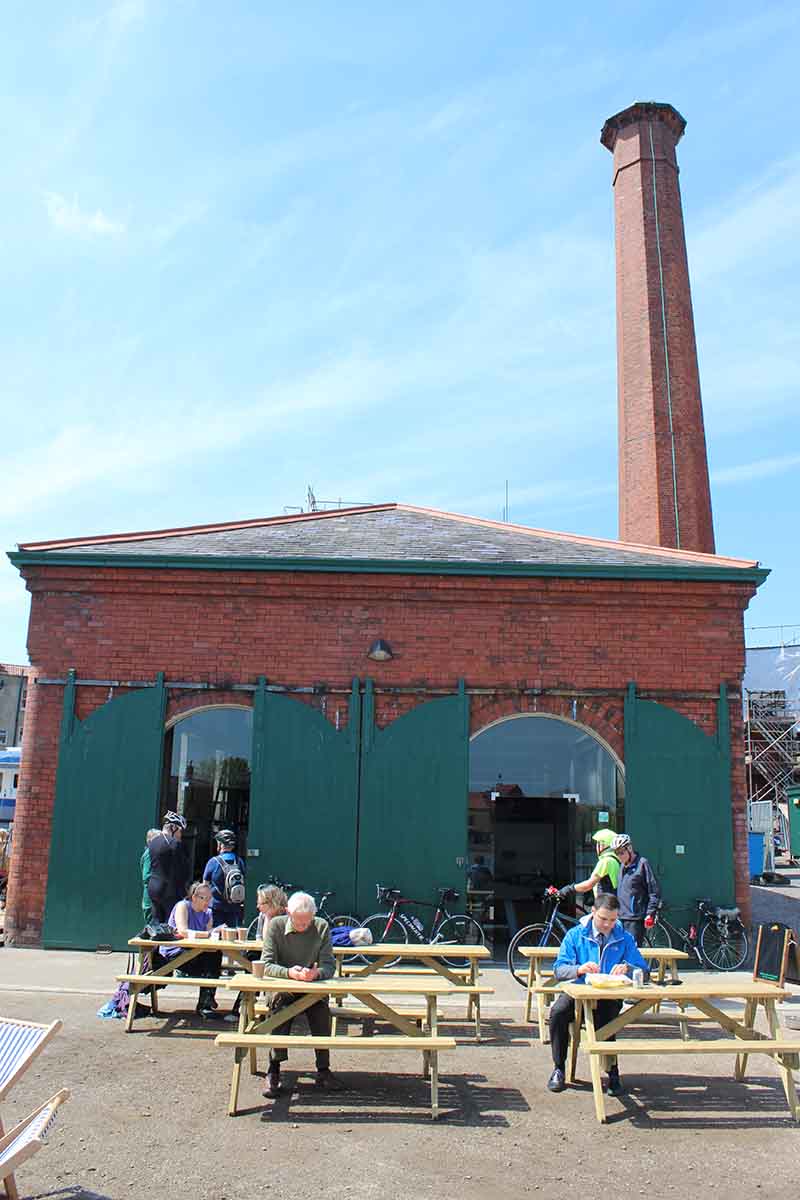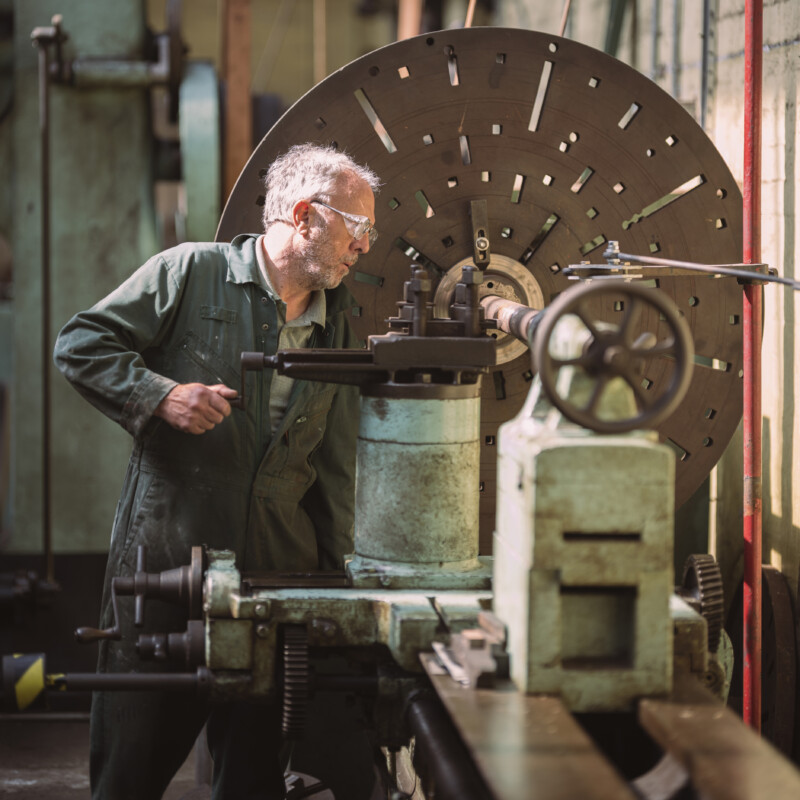
Underfall Yard in present day

Underfall Yard is home to maritime businesses involved in boatbuilding, marine engineering, metal working and training. Both the Harbour Master and the Docks Engineer are based there.
Their Visitor Centre opened in March 2016 with support from Heritage Lottery Fund, AIM Biffa Award National Heritage Landmark Partnership Scheme, Wolfson Foundation, Garfield Weston Foundation, Headley Trust, Pilgrim Trust, J Paul Getty Foundation and many more.
In May 2023 a devastating fire destroyed several boatbuilding sheds at the Underfall Yard. Underfall Yard Trust set up a crowdfunder to help restore the buildings and support the small businesses that have been affected by the fire. If you would like to donate please visit the JustGiving page here: www.justgiving.com/theunderfallyardtrust. A separate Just Giving page has been set up to help replace the boatbuilders' private tool collections, some very specialised, which are not covered by the company's insurance.
The story of Underfall Yard
Since the creation of the Floating Harbour in Bristol, in 1809, Underfall Yard has been crucial to its operation and maintenance. Before this time, much of the site was under water; the original course of the River Avon ran through Underfall Yard.
In 1809, as part of the creation of the Floating Harbour system, William Jessop developed the Overfall dam across the River Avon allowing surplus water from the harbour to flow into the New Cut. The river water carries lots of silt and as it enters the Floating Harbour, it slows down causing the silt to settle in the harbour. This silt builds up and reduces the depth making it difficult for ships to navigate. The Overfall dam had sluices next to it, which could be used to remove the silt, but the main method was to empty the harbour and dig it out. This process of digging the mud out was hugely disruptive to shipping and trade. In the 1830s, Isambard Kingdom Brunel was asked to propose a solution. He suggested further developing the original sluices and recommended the use of dredgers, a type of boat, to remove the silt. The sluices have been changed and renewed several times since and today's system was installed in the 1880s.
Docks maintenance facility
In the 1880s, under Docks Engineer John Ward Girdlestone, the whole yard was rebuilt to provide a single site for the workforce who maintained the city docks including: plumbers, electricians, blacksmiths, divers, engineers, fitters, shipwrights and many more. It is one of the only surviving Victorian dock workshops in the world.

Hydraulic power
Now the Yard's Visitor Centre, the Power House was completed in 1887 and converted from steam to electricity in 1907. It was operational until 2010; three large pumps drew water from the harbour and pressurised it before distributing it around the harbour, via the accumulator. The hydraulic network supplied power to cranes, swing bridges, lock gates, sluices and other functions around the docks.
Patent slip
There has been a slipway at Underfall Yard since at least the 1850s, when boatbuilders Ross & Sage built it. In 1890, Docks Engineer John Ward Girdlestone ordered the current slipway to be built, but it fell into disuse in the 1980s and was one of the first refurbishments by the Underfall Yard Trust in the 1990s. This sort of slipway, known as a 'Heave-up Slip', was patented in 1819 by shipbuilder Thomas Morton of Leith, Scotland.
Projects

With the support from the National Lottery Heritage Fund, the Yard aims to share understanding, knowledge and enjoyment with communities far and wide. This is being achieved through projects, such as:
Sharing Memories Project: with support from the Oral History Society, x10 volunteers were trained to interview and record memories of Underfall Yard; a treasure trove that has been shared in their Visitor Centre and on Vimeo.
Community Learning Page: in 2016 the team worked with Bristol City Council to run a pilot adult learning programme. x3 adults attending an 8-week 'Discovering Underfall' programme that taught them to:
— Measure and record tides;
— Explain how Underfall Yard got its name;
— Describe Underfall Yard businesses and skills;
— Master nautical knots;
— Carpentry skills, used by boatbuilders, to create shelves to take away.
They are hoping to run similar courses in the future for adults seeking ways into or back into work.
Research Project: in 2015-16, a dedicated team of volunteers spent over 1,000 hours scouring collections held in Bristol Records Office, M Shed, National Archives, British Library and many more to uncover fascinating stories about Underfall Yard. The results are proudly on display in their Visitor Centre and downloadable resources are available here.
Orchard School: Developing the Visitor Centre: in 2015-16 the team worked with x10 students from Orchard School to help get the Visitor Centre right. They worked diligently to get the text, images and games correct. The English as a Second Language department helped to translate some of our key vocabulary into different languages so that it is accessible to as many people as possible.
LATEST NEWS
October 2024 Planning permission was granted for the rebuilding of the Big Shed and lean-to workshops after the devastating fire in May 2023. Full story
Find out more:
Follow them on social media:



